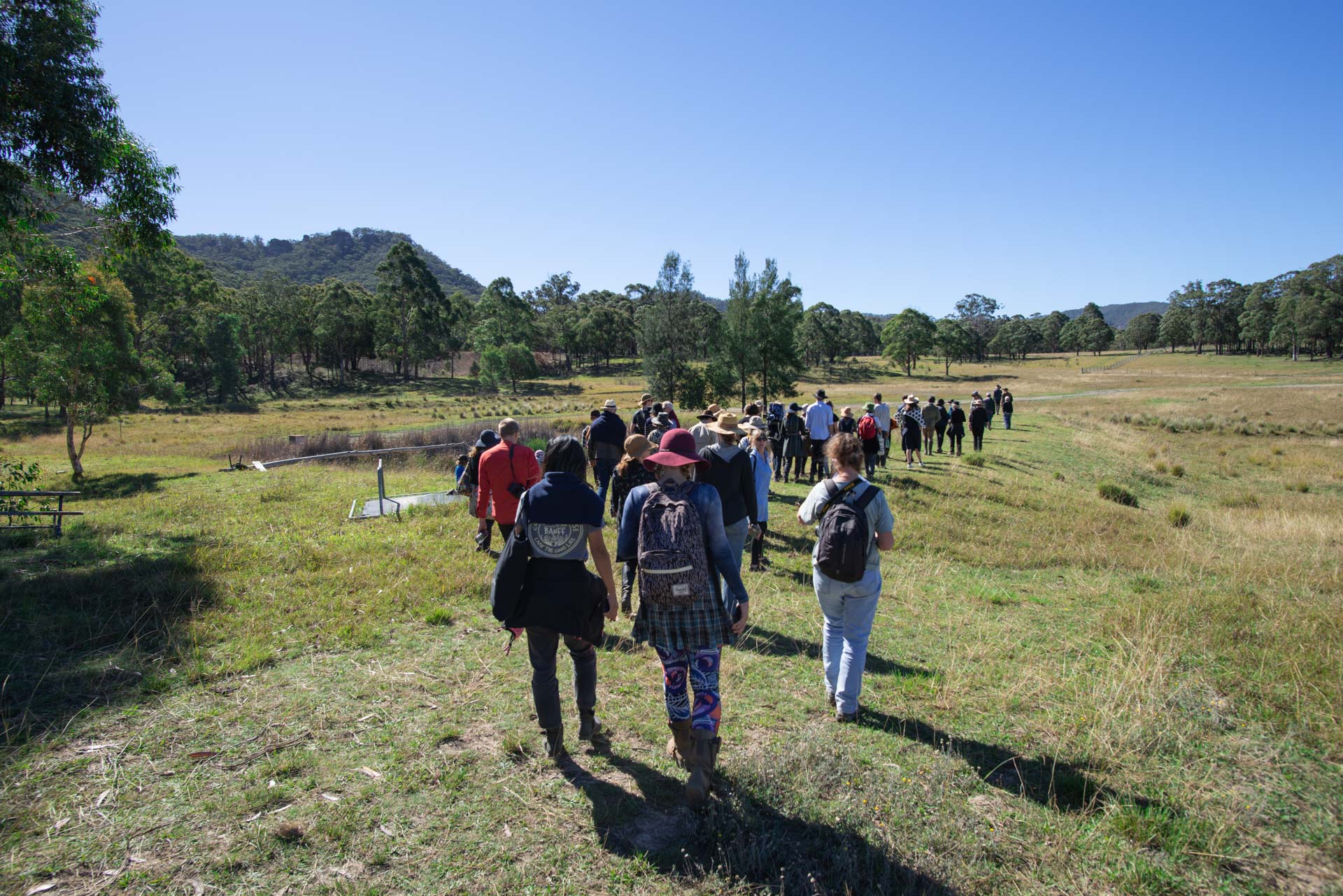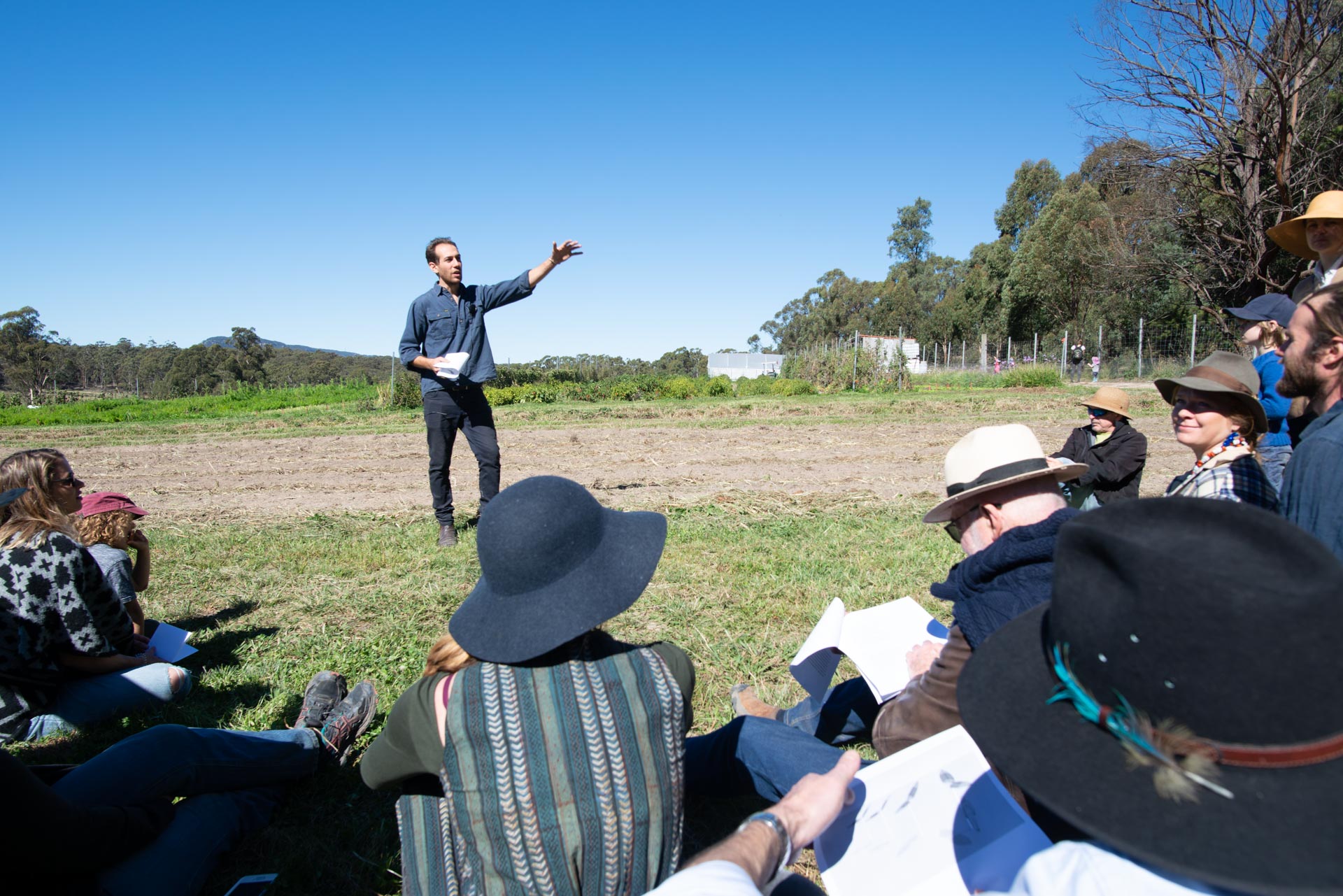Video time! Revisit that sparkling September weekend in Bingara…
Groundswell Gallery for September 8, 2019
Groundswell Gallery for September 7, 2019
Why The Long Drive to Bingara is actually a top idea.
A picnic, a walk, a scientist, an artist, a farmer, a dam, some cows, a market garden...
By Alex Wisser
It is difficult to decide what was more beautiful, the weather or the landscape as we gathered at Bula Mirri Farm in Hartley, to embark on our Art and Farming tour, picnic and conversation. Like WB Yeats, let us settle on the fact that you cannot tell the dancer from the dance, and the day, like the landscape, like the people gathered, like the food and the conversation, blended into a single experience that was its own whole, generous, warm, fascinating thing. Our sincere gratitude to our hosts Erika Watson and Hayden Druce for their hospitality and the generosity with which they opened their farm, and their experience as farmers up to us.
The day began with an intro from Ian Milliss and a little conversation with Erika and Hayden before we headed off down the dirt road to the Keyline dam that they are building on the property. The principles of Keyline farming originate with farmer/inventor PA Yeomans, who was the subject of a project that was an early antecedent of all that KSCA does now. His work is now part of the dna of the permaculture and regenerative farming movements.
I was blown away by the scale of their ambition. This dam is only half finished, and the funds raised through our event will contribute to its completion.
The story behind this dam includes the story of the severe drought that Australia is now facing. It was the perfect backdrop to understand the scale of the problem and the importance of converting to regenerative farming methods, much of which is predicated on principles of water retention in healthy soil and well managed landscapes.
Our next stop was a small cell grazing operation. Hayden explained how the cattle can be used to improve soil and create nutrient inputs for the market garden that is the main business of the farm. These cattle are not being raised for their meat, but for their ability to improve the soil.
It was at this point that I learned something about our Artist Farmer Scientist project that I had not realised before. Erika and Hayden spoke eloquently of the struggle of farming, the challenges of working under drought conditions to raise enough produce to make a living and to care for the land at the same time. While the picturesque setting and the idealism of their endeavour might have appealed to us day trippers, I imagine that the daily grind and the isolation of farming could get dire. Having talked to enough farmers, you come to understand why depression and suicide are such prevalent issues. Erika and Hayden were able to turn to the idea of art, re-conceiving their work as artistic making, a gesture that would re-energise their project. As KSCA proceeds with our strange project of attempting to engage art in the real world (in this instance, the real world of farming), I have thought about a number of the ways that art can contribute to real world cultural change. Art, for instance, has the capacity change perception, disrupt conventional thinking and to communicate with diverse audiences. But it had not occurred to me that art could play this important role as well. It reminded me that culture, when it is practiced in a manner that is integrated into daily life, can motivate that life with the meaning that it produces, as well as connecting those who practice it together. Seeing this great crowd of people on this farm, keen to overcome the abstraction and detachment through which farming is commonly perceived, was a benefit to the farmer as much as anyone else - connecting them into the society which they fed.
Artist Mark Swartz is seen here speaking in front of the patch of the market garden which has been allocated to ‘the solar garden’ project. He, Erika and Hayden and solar scientist Bjorn Sturmberg, are nutting out how solar-panelled sculptures or ‘trees’ could be installed here. They could function as a ‘storey’, harvesting sunlight to power things like irrigation pumps, while also providing modest shade to other plants.
We finally returned to the marquee and had our picnic. And a pleasant picnic it was, before we returned to the serious business of talking about art and science and farming.
Artist Allan Giddy discussed his long history of working with solar and alternative energy in artworks. He wowed the crowd with his first solar artwork that he made back in 1994, and his recent work Flow. Mark Swartz spoke about the journey he and scientist Bjorn Sturmberg have taken to conceive of a work that would fit within the farming environment. A poignant discussion followed around the challenges of communication. Erika and Hayden spoke of the intensity of feeling farmers experience during drought, how much they care for the land and their livestock. Mark made the salient point that though this was true, farmers were on the whole not very good at communicating this relationship. Erika replied that this was often because the relationship was too big, too complex and overwhelming for words. Mark pointed out that this was exactly why artists could be useful - because we work visually, and conceptually, and are often able to convey complex emotion and ideation in a single intuitive hit.
Allan Giddy demonstrates a solar machine that counts down his mortality. It has been running for several decades.
This conversation was complemented by solar scientist Bjorn Sturmberg’s commentary (Bjorn joined us via skype), which revealed another aspect of our project that had not yet occurred to me. Bjorn spoke about the struggle to conceive of a work that would satisfy the artist’s need for aesthetic presentation, the scientist’s concern with efficiency and the farmer’s need to consider production. It was a fascinating description of the consequences of putting four people from highly specialised disciplines together to create something. The diversity of perspectives was disruptive to each category of knowledge. By asking these individuals to consider an object in common, we were asking them to think of it holistically, as an integrated object that is at once cultural, scientific, and agricultural. This appears as a problem, because most of us are very good at comprehending things in isolation, and completely incompetent at apprehending them as embedded within a complex reality. Was this not the point that Erika and Hayden had raised when they spoke of the need to make farming into a cultural activity?
This is something regenerative farmers have constantly said to us throughout this project: that ecological systems are complex and made more so by human social and cultural systems. How then can we think about them properly, if we insist on reducing them to the simplicity demanded by our conventional means of understanding? Perhaps then we should follow the poet and recognise that there is no distinction between the dancer and the dance.
Nothing left to do, but to keep walking out on the limb we find ourselves on.
Meet Allan Giddy
Art Farming and Cultural Change, oh my!
When the folks at Lyttleton Atelier approached us with the idea of mounting an exhibition of works in progress from the Artist Farmer Scientist project in their window gallery, we very promptly and enthusiastically said yes please.


























